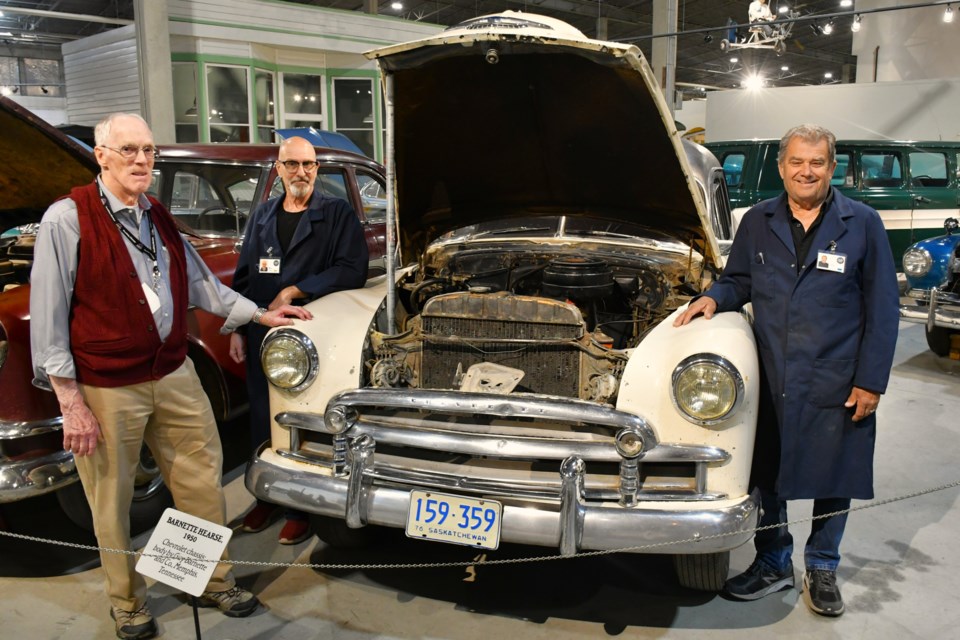MOOSE JAW — Car enthusiasts had plenty to talk about at the Western Development Museum (WDM) last weekend, as a new feature gave visitors a closer look at what keeps its vintage vehicles in museum-worthy shape.
The inaugural “Pop the Hood” event took place on June 14, just in time for Father’s Day. Throughout the day, guests were invited to tour the Transportation Gallery, chat with volunteers, and take a peek under the hoods of several antique cars that have been painstakingly preserved by a new team of volunteer detailing technicians.
“We’re here to preserve the collection; we’re not here to restore the collection,” said Mike Stobbs, who joined the museum’s volunteer team in January alongside fellow detailers John Westervelt and Russell Wheatley, the newest member of the crew.
“We basically keep (these vehicles) clean and just preserve them. We don’t try to repair anything that’s damaged or anything like that. They want to have them exactly the way they came into the hands of the museum,” he explained.
Preserving each vehicle also involves researching and documenting its background story. Stobbs said the team adds to the museum’s archives by digging up historical information about each vehicle’s previous owners, uses, and modifications.
Stobbs pointed to one example on the gallery floor, a rare 1951 Barnette-built hearse with a newly cleaned up engine compartment. The car originally started life as a sedan delivery vehicle before being sent to Memphis, Tenn., where the Guy Barnette Company stretched it into a functioning hearse — a process that was done by hand as the factory was not tooled to mass-produce these specialized vehicles.
Operating from 1947 to 1955, Barnette specialized in converting Chevrolet and Pontiac sedan delivery vehicles into professional hearses and ambulances. These conversions were extremely limited, with only a few produced each year. Experts estimate Barnette made just a few dozen in total, making them rare and highly sought-after by collectors.
“They handmade all this stainless steel for it, because that wouldn’t have been original,” Stobbs said, pointing to the driver’s side trim. “They handmade the doors, the windows, the trim, lengthened the roof on the car, and then it went into duty as a hearse.”
The vehicle served its operational life in Tisdale, Sask., remaining operational until 1974, when it was acquired by the WDM in 1978. Today, it still features its original simulated leather interior, bag-style washer fluid container, and some aftermarket additions such as a rare external oil filter.
In the mid-20th century, some cars used toilet paper in bypass oil filters like the Frantz system. It worked well for trapping fine particles but isn’t suitable for modern engines or as an air filter.
“I had a ’62 Nova that had an aftermarket filter like this, and it took a roll of toilet paper as the filter,” Stobbs confirmed.
Detailing sessions take place once a week, with volunteers coming in every Wednesday morning from 9 a.m. to noon. It takes roughly a month’s worth of sessions to fully detail a vehicle.
“We’re car guys that do this. We kind of want to have them look like our own rides at home,” Stobbs added, speaking to an urge to polish the chrome and replace blown hoses. “But we get ourselves conditioned to it … and we look forward to doing it.”
He said Saturday’s event brought in visitors from as far away as the United States and Newfoundland and was a strong first showing for a brand-new addition to the museum’s programming.
For more information, visit WDM.ca. Alexis Jones, the museum’s program and volunteer co-ordinator, can be reached at 306-693-5989 or by email at [email protected].
The Western Development Museum in Moose Jaw is located at 50 Diefenbaker Drive.




